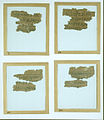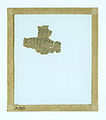Papyrus 62
| New Testament manuscript | |
| Name | Papyrus Osloensis 1661 |
|---|---|
| Text | Gospel of Matthew † |
| Date | 4th century |
| Script | Greek-Coptic |
| Found | Egypt |
| Now at | University of Oslo |
| Cite | L. Amundsen, Christian Papyri from the Oslo Collection, Symbolae Osloenses 24 (1945), pp. 121-147. |
| Size | 6.5 cm x 5.6 cm |
| Type | Alexandrian text-type |
| Category | II |
Papyrus 62, also known as ‘‘Papyrus Osloensis’’, is a copy of the New Testament and Septuagint in Greek and Coptic known as a diglot. It is designated by the siglum 𝔓62 in the Gregory-Aland numbering of New Testament manuscripts. It is a papyrus manuscript of the Gospel of Matthew and Book of Daniel in a fragmentary condition. Using the study of comparative writing styles (palaeography), it has been assigned to the 4th century CE.
Description
[edit]The original manuscript would have been a codex (precursor to the modern book) made of papyrus. Unfortunately it has only survived in a fragmentary condition, containing evidence of Matthew 11:25-30, Daniel 3:51-53, and some verses from the Book of Odes.[1] The Daniel and Odes portions are labelled as Papyrus 994 in the Alfred Rahlf's numbering of Greek Septuagint manuscripts.[1] The surviving fragments evidence around 13 leaves of the original codex. The text is written in one column per page, 7 lines per column, 7-12 letters in line.[1] It has diaeresis over the letter upsilon.[1]
- Contents
- Greek
Matthew 11:25; 11:25; 11:25-26; 11:27; 11:27; 11:27-28; 11:28-29; 11:29-30; 11:30.
- Coptic
Matthew 11:25-29.[1]
The manuscript contains evidence of the nomina sacra (sacred names, these being words/titles considered sacred in Christianity). The following are seen within the manuscript: θς (θεος / God), ις (Ιησους / Jesus), κε (κυριε / Lord/Master), πρ (πατηρ / Father), πηρ (πατηρ / Father), and υς (υιος / son).[1]
- Transcription of Greek text of Matthew
- 25εν εκεινω τω καιρω̣ αποκριθεις̣ ειπεν ο [ις] ε̣[ξομολογο]υ[μαι] [σοι] [πρ] κ[ε] [του] [ουρα]
- νου και της γ̣η̣ς οτι εγρ̣υ̣ψας ταυ[τ]α̣ απο σο[φων] [και] [συ]ν̣[ετων] [και] απ[εκαλυψας]
- αυτα νηπιοις 26 ναι ο πηρ οτι ουτως ευδοκι̣[α] –
- 27 παντα μοι παρεδοθη υπο̣ του π̣α̣τ̣[ρ]ο̣ς̣ μ̣ο̣υ̣ – [υι]
- ον ει μη ο πατηρ ουδε το[ν] πατερα τ[ις] [ε]π̣ιγινω[σκει] –
- αποκαλυψαι 28 δ̣ε̣υτε προς μ̣ε παντε[ς] [οι] κοπιον̣[τες] – [αναπα]
- υσω υμας 29 α̣ρατε τον ζ̣υ̣[γο]ν μου εφ̣ [υμ]α̣ς̣ και μ̣α[θετε] – [τα]
- πεινος τ̣η κ[αρ]δ̣ια και ευ[ρ]η̣σ̣ε̣τε αν̣[απα]υ̣σιν ταις –
- 30 και τ̣ο φορτιον μου ελα̣[φρο]ν εστιν
Text
[edit]The Greek text of the Gospel of Matthew is considered a representative of the Alexandrian text-type. Biblical scholar Kurt Aland placed it in Category II of his New Testament manuscript classification system.[2] In Matthew 11:25 it reads εκρυψας along with Codex Sinaiticus, Vaticanus, Bezae, minuscule 33, and lectionary 2211. Other manuscripts read απεκρυψας (C, L, W, Θ ƒ1, ƒ13, Byz).[3] The text of Daniel represents Theodotion's recension.[1]
History
[edit]Leiv Amundsen dated the manuscript to the 4th century. INTF dated it to the 4th century.[2] The manuscript was found in Egypt. The text was published by Amundsen in 1945. It was examined by Maldfeld, Kurt Treu,[1] and Karl Jaroš.[4]
It is cited in critical editions of the New Testament (NA26, NA27). It is currently housed at the University of Oslo Library (Inv. 1661) in Oslo.[2][5]
Image gallery
[edit]-
Mat 11.25-30 recto 1 3 5 7
-
Mat 11.25-30 verso 18 20 22 24
-
Mat 11.25-30 recto 25
-
Mat 11.25-30 recto 17 19 21 23
-
Mat 11.25-30 verso 10 12 14 16
-
Mat 11.25-30 verso 26
-
Mat 11.25-30 recto 9 11 13 15
-
Mat 11.25-30 verso 2 4 6 8
See also
[edit]References
[edit]- ^ a b c d e f g h Aland, Kurt; Rosenbaum, Hans-Udo (1976). Repertorium der Griechischen Christlichen Papyri. Berlin: Walter de Gruyter. p. 54.
- ^ a b c Aland, Kurt; Aland, Barbara (1995). The Text of the New Testament: An Introduction to the Critical Editions and to the Theory and Practice of Modern Textual Criticism. Translated by Erroll F. Rhodes. Grand Rapids: William B. Eerdmans Publishing Company. p. 100. ISBN 978-0-8028-4098-1.
- ^ NA26, p; 28.
- ^ LDAB
- ^ "Liste Handschriften: Papyrus 62". Münster: Institute for New Testament Textual Research. Retrieved 7 April 2011.
Further reading
[edit]- Leiv Amundsen, Christian Papyri from the Oslo Collection, Symbolae Osloenses 24 (Oslo: 1945), pp. 121–147.








